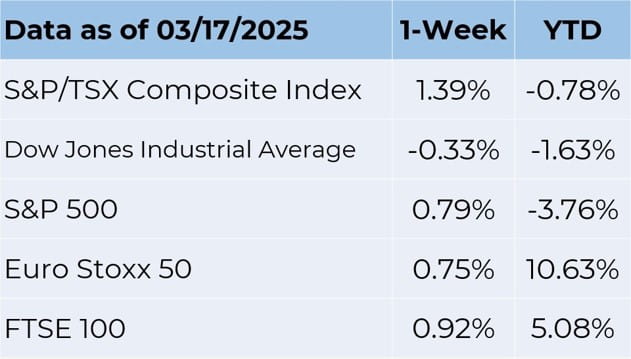Weekly Market Commentary March 25 2025
Trade Tariff Impacts
According to Bank of Canada governor Tiff Macklem, tariff uncertainty is causing a strain on business spending and hiring; it's also shaken consumer confidence. The remarks come following the central bank cutting the overnight lending rate by 25 basis points to 2.75 per cent when the economy is under immense pressure amid the ongoing trade war with the U.S.
The Canadian economy started the year on a firm footing with solid gross domestic product growth and inflation within the recommended two per cent target. According to Statistics Canada, foreign investors purchased $7.9 billion worth of Canadian assets in January, with the Canadian bond market seeing the most significant monthly investment since April 2020.
In the meantime, Canadian investors sold $3.2 billion worth of foreign securities, primarily U.S. stock securities. There were 229,000 housing starts in February, down from 239,000 in the same month last year.
Things have since taken an unexpected turn, as Canada has been forced to react to U.S. aggression on trade tariffs. Likewise, there is growing concern that the heightened tariff pressure will once again trigger higher inflation, as prices of goods rise due to the tariff's impact.
While it is the seventh interest rate cut by the BoC, there are growing concerns that the economy needs it the most to navigate the pitfalls of the trade war. For starters, Canadian businesses have no option but to raise product prices to try and offset the impact of tariffs. Even though less spending by businesses and consumers tends to put downward pressure on inflation, rising product prices could trigger it.
There are a number of potential causes for inflation. Importers face difficulties due to the weak Canadian dollar, making the goods they bring more costly. Retaliatory tariffs levied by Canada will also increase costs and uncertainty, which causes businesses to search for new suppliers and markets to survive. Macklem has previously cautioned that the bank may use interest rates to control a possible spike in inflation. Still, it cannot protect the Canadian economy from the financial effects of tariffs.
In sharp contrast to the anger directed at Canada by U.S. President Donald Trump, Canada's new prime minister, Mark Carney, was welcomed with open arms in Europe, on his first foreign visit as leader. Carney chose France as the destination for his first foreign visit. Carney's cordial reception in Paris coincides with Canada's relations with the U.S. at a low point in recent history.
Meanwhile, the Canadian stock market remains on edge, even as it continues to outperform the U.S. stock market. The country’s main stock index, the Toronto Stock Exchange, is only down by 4.5 per cent from its recent high. In contrast, the S&P 500 has already sunk into deep correction territory and bounced back, but it is still down by about 7.1 per cent from all-time highs.
The ongoing pullback in the equity market comes amid growing concerns that the U.S. and the Canadian economic growth are slowly shifting towards a slower gear. Economic data already signal software consumption, and consumer sentiments signal weariness. Additionally, the economies are cooling at a time when uncertainty surrounding government policies and tariffs is still high.
The Markets
A correction and a bounce.
Last week, the Standard & Poor’s (S&P) 500 Index moved into correction territory. The Nasdaq Composite Index (Nasdaq) was already in a correction, and the Dow Jones Industrial Average (Dow) was close, reported Paul R. LaMonica of Barron’s.
A correction occurs when the value of an index drops 10 per cent below its most recent peak. The S&P 500 correction occurred remarkably quickly. Just three weeks ago, the index was at a record high amid easing inflation pressures and solid earnings growth.
In fact, from December 15 through March 6, the number of companies mentioning the word “recession” on earnings calls was the lowest it had been in more than five years, reported John Butters of FactSet. There is another word that was mentioned frequently on earnings calls though: tariffs.
Tariffs on tariffs on tariffs
The tariff war escalated last week as the European Union (EU) and Canada introduced retaliatory tariffs in response to those of the United States, reported Joe Light of Barron’s. Brendan Murray and Alex Newman of Bloomberg have been tracking the tariffs. Through the end of last week, the United States government has imposed the following tariffs:
- 10 per cent on all goods imported from China (February 4)
- An additional 10 per cent on all goods imported from China (March 4)
- 25 per cent on some Canadian imports (March 4) 25 per cent on some Mexican imports. (March 4)
- 10 per cent on Canadian energy and potash (March 4)
- 25 per cent on steel and aluminum from major exporting countries (March 12)
“As Americans debate the wisdom of the administration’s on-again, off- again trade barriers…a few broad points are worth bearing in mind,” wrote The Editorial Board at Bloomberg. “One is that these measures are a tax on Americans. Foreign countries don’t simply pay up; U.S. companies do when they import a product. This means that the costs are ultimately borne by consumers and by companies that use imported inputs. The effect of those higher prices is to eat into household budgets, push down real wages and reduce economic growth.”
Consumers are feeling salty
The trade war has raised questions about the path of the U.S. economy, and some economists have lowered their forecasts for economic growth in 2025, reported Brian Swint of Barron’s.
The primary driver of U.S. economic growth is consumer spending, and consumers – anyone and everyone who buys things – are feeling less optimistic. Last week, the University of Michigan Survey of Consumers reported that sentiment fell 10.5 per cent from February to March.10 Surveys of Consumers Director Joanne Hsu wrote:
“Sentiment has now fallen for three consecutive months and is currently down 22 [per cent] from December 2024. While current economic conditions were little changed, expectations for the future deteriorated across multiple facets of the economy, including personal finances, labour markets, inflation, business conditions, and stock markets. Many consumers cited the high level of uncertainty around policy and other economic factors; frequent gyrations in economic policies make it very difficult for consumers to plan for the future.”
Major U.S. stock indices fell over much of last week before recovering some losses on Friday. The S&P 500, Nasdaq and Dow all finished the week more than two per cent lower. U.S. Treasury yields bobbed lower before finishing the week close to where they were the previous Friday.

Source: FactSet
Keep Your Eyes On Your Financials Goals.
While it is never comfortable to watch the value of savings and investments fall, as they do during a market correction, it’s important to remember that the decisions you make today can have a significant effect on the value of your portfolio over the long term. During market downturns, investors generally have three choices. They can:
- Sell and take a loss. The thinking behind selling is usually something like this: If I sell, I will cut my losses and preserve what I Investors who do this realize a loss of principal. “A lesson many investors have learned is that if they sit tight and wait for the upturn to come, they won't realize a loss. In fact, they may even see their portfolios gain more value than they had before the downturn,” wrote Richard Bet of Investopedia.
- Sit tight. Investors who stay invested recognize that a market decline is not the same as a loss of These investors understand that staying invested through market ups and downs can help them reach their long- term financial goals. The odds of a positive return increase with the amount of time an investor holds a stock or stock portfolio, explained Trevor Jennewine via Nasdaq. Historically, the chance of the S&P 500 Index delivering a positive return were:
- 59 per cent over a month period. 69 per cent over a year.
- 79 per cent over five years. 88 per cent over 10 years.
- 100 per cent over 20 years.
- Look for A lot of investors recognize that market downturns create opportunities to purchase shares of attractive companies at lower prices. These investors work with their advisors to identify opportunities that may benefit their portfolios, should the market recover. The goal of investing, after all, is to buy low and sell high.
If you’re feeling fearful, remember that corrections are a normal part of investing. The S&P 500 Index has experienced 56 corrections since 1929, reported Saqib Iqbal Ahmed of Reuters. Corrections tend to occur when share prices become overvalued. They wring out the excess and often create opportunities for investors.
Weekly Focus – Think About It
“The dark does not destroy the light; it defines it. It's our fear of the dark that casts our joy into the shadows.”
–Brené Brown, Author
Best regards,
Eric Muir
B.Comm (Hons. Finance), CIM®, FCSI
Senior Portfolio Manager
Derek Lacroix
BBA, CIM®, CFP®
Associate Portfolio Manager

P.S. Please feel free to forward this commentary to family, friends or colleagues. If you would like us to add them to the list, please reply to this email with their email address and we will ask for their permission to be added.
Disclaimer:
Information in this article is from sources believed to be reliable, however, we cannot represent that it is accurate or complete. It is provided as a general source of information and should not be considered personal investment advice or solicitation to buy or sell securities. The views are those of the author, Eric Muir and Derek Lacroix and not necessarily those of Raymond James Ltd. Investors considering any investment should consult with their Investment Advisor to ensure that it is suitable for the investor’s circumstances and risk tolerance before making any investment decision. Raymond James Ltd. is a Member Canadian Investor Protection Fund.

